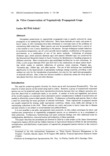In Vitro Conservation of Vegetatively Propagated Crops
JIRCAS international symposium series
| ISSN | 13406108 |
|---|---|
| 書誌レコードID(総合目録DB) | AA1100908X |

本文フルテキスト
intlsymp-2_174-180.pdf267.35 KB
Germplasm preservation in vegetatively propagated crops is usually achieved by using propagules or by maintaining field collections. Since these methods are costly and prone to heavy losses, in vitro techniques have been developed to overcome some of the problems of maintaining field collections. Many species can now be successfully stored from a period of a few months to over 3 years, depending on the species. Storage techniques include reduction in incubation temperature, use of a slow growth culture medium, modification of the gaseous environment, or a combination of any of the above methods. Collections of potatoes (Solanum spp.), sweet potatoes (Ipomoea spp.) and cassava (Manihot spp.) are preserved by the International Research Centers in South America for distribution to breeding programs in different countries. Most countries have also established facilities for in vitro collections. In Chile, a joint project between INIA and JICA led to the construction of tissue culture facilities which enable to maintain collections of potatoes, sweet potatoes, Fragaria spp., Vaccinium spp., Allium spp., and other species. The use of this technique has contributed significantly to the improvement of germplasm exchange among countries, providing a safe method not only for the introduction of germplasm, but also for the rapid micropropagation of selected cultivars. Also, it has now become possible to effectively screen for virus and obtain plants free from virus and other diseases.
| 作成者 | Carlos MUÑOZ Schick |
|---|---|
| 公開者 | Japan International Research Center for Agricultural Sciences |
| オンライン掲載日 | |
| 号 | 2 |
| 開始ページ | 174 |
| 終了ページ | 180 |
| 言語 | eng |
